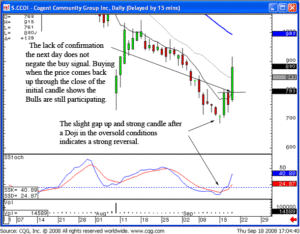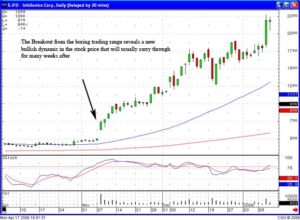Trading Strategies for Playing the Stock Market
Trading strategies discussed in this article include swing trading and day trading. Both are very similar but the main difference between theses two strategies is the time frame in which stocks are bought and held. In today’s article we will discuss both of these strategies as well as the advantages and disadvantages of each.
Swing trading typically involves a smaller position size than when day trading stock online. Additionally, swing traders will typically hold onto stocks for a few days to several weeks and then trade the stock on the basis of its intra-week or intra-month movements. Stop loss orders are placed wider than when day trading as well. When determining exits when swing trading there are rules that every trader should follow. It is very important that the trading strategies as well as the trading rules are understood before placing trades in this fashion. For instance, if the prior day’s low is taken out on the breakout day, or the high for shorts, then the trader should exit the trade. Also, once a trade is held overnight, a stop loss order should be placed no further away than below the recent consolidation area. A move beneath it would indicate a failure.
Swing trading stocks has its advantages and disadvantages as all trading strategies do. Some advantages include that swing traders can place fewer trades, therefore requiring fewer commissions and less chance of making a mistake. Additionally this type of stock trading provides the ability for successful traders to catch more significant multi-day profitable traders. A disadvantage to swing trading is the fact that the higher profit targets come with higher risk per trade. There is also overnight exposure that cannot be predicted.
Day trading stocks requires a larger positions size since you are looking for a smaller move within a short time frame. Unlike swing traders, a day trader may trade a few times per day or more! There are also rules with day trading that every investor should follow. For instance, they should always keep their profit objective at least 3 times greater than what they are willing to risk. Also, day traders should allow no more than 1% move against them from the entry point. There are many more trading strategies and rules when day trading that investors should learn in addition to these two rules.
Day trading also has its advantages and disadvantages as well. When day trading there is no overnight hold exposure and investors can profit from both long and short and take advantage of quick swings in both directions. There is also a higher percentage of winning trades when taking quicker profits and smaller investment risk. The disadvantages to this type of trading can be the trading costs which tend to be high when trading as frequently as you do when day trading. Also this investment strategy requires constant attention to the markets and a lot of effort.
Both trading strategies are a great way to make money in the stock market. Continue to research them both as well as other strategies and find one that works for you.
The true benefits of candlestick analysis revealed itself over the past week. For the past two months there has been a sideways, indecisive trading trend, especially in the Dow. But as the trading proceeded this summer, a definite Candlestick pattern was developing. A Dumpling Top! The Dumpling Top is the opposite of a Fry Pan Bottom. It is a slow rounding top that clearly demonstrates a gradual decline of investor sentiment. Despite the fact that stochastics were heading toward the oversold condition, the result of the buildup of negative investor sentiment usually will culminate in a dramatic down move. The opposite is true in a Fry Pan Bottom pattern. The eventual buildup of bullish sentiment gets the best results once a break out has occurred at the end of a pattern.
As seen in the past few months, the commentary of what the market direction was doing was not very specific. This was the result of a sideways market that was not showing any definite direction or candlestick signal confirmation. That does not necessarily mean there was a lack of trend analysis. The trend analysis was there was no definite trend. This is what the Japanese Rice traders mean when they say “let the market tell you what the market is doing”. Having that knowledge allows an investor to make the proper allocation to their trading program. That could either be trading on a very quick basis, scalping short term profits, or staying out of the market altogether.

DOW
But like all market conditions, they eventually change. The more the sideways activity of the Dow occurred, the more clear it became that a slow rounding top was forming. This made the projection of a hard sell-off more anticipated. Why? Because that is usually the result of a Dumpling Top pattern. Candlestick analysis allows an investor to finely tune their analysis for a price trend. Knowing what the results should be from a specific signal or pattern makes for very simple “if/then” expected results. The different elements of a market trend can be analyzed instantly based upon the visual characteristics included in the signals and patterns. The downtrend of the past week was more readily anticipated because of the pattern that was being formed. Taking advantage of sell signals for short positioning or buying the short funds is the result of knowing what a Dumpling Top pattern should produce.
This is not difficult information to learn. The signals and patterns are the product of common sense investment perspectives put into a graphic depiction. The basis of candlestick signals is to inform what is going on in investor sentiment. Once that information is known, the appropriate trading strategies can be applied. The Dow formed a huge Bullish Harami today, retracing 410 points of its 449 point loss yesterday. What is required to confirm a Bullish Harami? Additional bullish trading the next day! Note how the Dow came up and just touched the tee line. What would we like to see to it instigate bullish positions tomorrow? Positive trading bringing the Dow up through the tee line! Would this be a comfortable time to be buying and letting positions run? Probably not, not until the rounding top configuration was breached. This would mean any long positions put on tomorrow should be watched diligently to see if the Dumpling Top is still going to act as the predominant analytical feature or if the Bullish Harami will instigate strong enough buying to breach the downward trajectory of a Dumpling Top. This means keeping a finger on the trigger.
Each signal and patterns creates expected results. The Candlestick Forum recommended CCOI a few days back after a gap up from a Doji. What was required the next day to enter the trade? Bullish confirmation! However, with the price opening lower the next day, a direct result of the bearishness in the markets, the position was not executed. What becomes a simple entry strategy?
If the price came back up through the closing price of a bullish candle that indicated the Bulls were taking control, that would be confirmation the Bulls were still in the trade. Candlestick signals provide very simple and effective entry and exit strategies for successful investing. It is all based upon common sense investment principles applied to a chart pattern.

CCOI
The Candlestick Forum Online Training Program
The Candlestick Forum Online Training program scheduled for September 20 and 21st has been postponed to October 4th and 5th due to the effects of Hurricane Ike in the Houston area. We will get more details to everybody in the coming weeks. We apologize for the inconvenience but due to the lack of power and Internet connections in Houston, we have not been able to disseminate information in the proper manner.
Also, our apologies for those that have been tried to order or communicate with us over the past few days. The Candlestick Forum staff will be working extensively to get caught up on all communications as soon as we have access to the Internet.
Chat Session – we will have a chat session tonight at 8 p.m. ET. Everybody is welcome. We will be discussing the ramifications of a dumpling top and how to trade these market conditions. Come join us.
Good investing,
The Candlestick Forum Team
